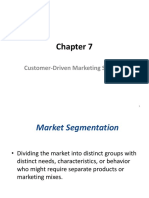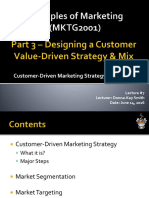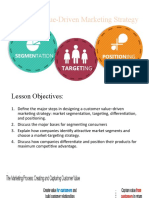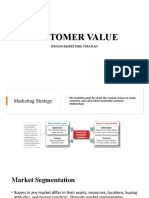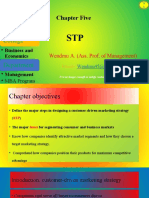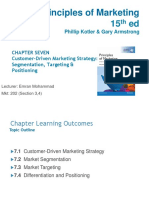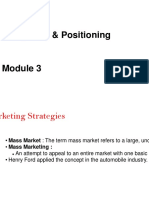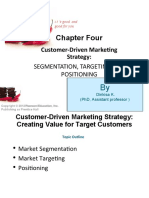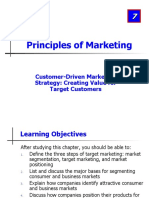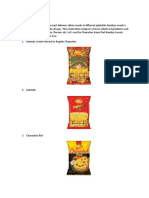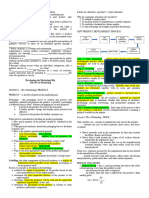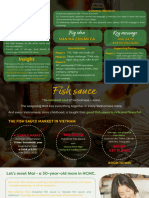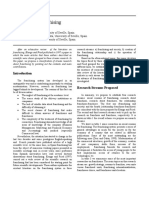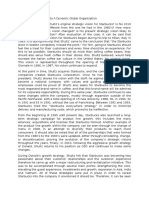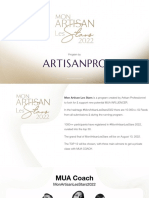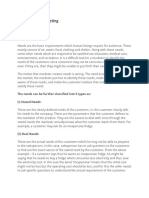Chapter 7
Customer-Driven Marketing Strategy
1
� Market Segmentation
• Dividing the market into distinct groups with
distinct needs, characteristics, or behavior
who might require separate products or
marketing mixes.
2
�3
�4
� Bases for Segmenting
Consumer Markets
3. Behavioral
C 1. Demographic
H
A
R
A
C
T
E
R 4. Psychographic
I 2. Geographic
S
T
I
C
S
5
�Geographic
Region
City or metro size
Density
Climate
6
�Demographic regions
Age/Family size & life cycle
Gender/Income
Race/Religion/Nationality
Occupation/Education
Generation/Social class
7
�8
�9
� Psychographic
Lifestyle Personality
10
�11
�12
� Market Segmentation
Behavioral segmentation divides buyers
into groups based on their knowledge,
attitudes, uses, or responses to a product.
• Occasions
• Benefits sought
• User status
• Usage rate
� Occasion Segmentation
• Dividing a market into different groups
according to occasions when buyers get idea
to buy, actually make their purchase or use
the purchased item.
• Cards for Eid, Diwali, Birthday, Friendship day,
Valentine’s day.
14
�15
�16
� Benefit Segmentation
• Dividing a market into different groups
according to the different benefits that
consumers seek from the product.
• Ex: Lifebuoy - 100% Protection. Clinic –
Dandruff free.
17
�18
� User Status
• Non Users, Ex Users, potential users, first time
users and regular users.
• Think about blood bank. Also a mother to be.
19
�20
�21
�22
�23
�24
� Usage Rate
• Light, Medium and Heavy Users.
• Like: Mobile phone users, Internet users.
25
�26
� Target Marketing
• The process of evaluating each market
segment’s attractiveness and selecting one or
more segments to enter.
27
� Target Marketing Strategies
Undifferentiated Differentiated Concentrated
(Mass) (Segmented) (Niche) Micro Marketing
Marketing Marketing Marketing
Targeting Targeting
Broadly Narrowly
28
� Target Marketing Strategies
• Undifferentiated (Mass) Marketing:
Ignore Market segment differences
Whole Market = One offer
Focuses on what is common in the needs of
consumers.
Relies on mass distribution & Advertising.
Aims to give the product a superior image.
Difficult to develop a Product or Brand following
this strategy.
Often have trouble competing with more
focused firms. 29
� Target Marketing Strategies
• Differentiated Marketing:
Target several segments & design separate
offerds for each.
Ex: Nike athletic shoes for basketball, fencing,
golf, aerobics bicycling, baseball.
Hope for higher sales and stronger position
within each market segments.
More brands = more money.
Negatives: development, research, channel,
promotional cost.
30
�31
�32
� Target Marketing Strategies
• Concentrated Marketing:
When company resources are limited; instead of
going for a small share of a big market; a firm
goes for a large share of one or a few segments
(Niches).
It can market more effectively by fine tuning
products, prices, programs to the need of
carefully defined segments. Also Market
efficiently targeting its products, channels,
communications programs towards only
consumers that it can serve best and most
profitably.
33
�34
� Target Marketing Strategies
• Micromarketing: Tailoring products and
marketing programs to the needs and wants
of specific individuals and local customer
groups.
Local Marketing: Tailoring brands and promotions to
the needs and wants of local customer groups – cities,
neighborhoods, and even specific stores. DRAWBACK:
Increase cost by reducing economies of scale, logistic
problems, confusion in Brand Image.
Individual Marketing: Tailoring products and
marketing programs to the needs and preferences of
individual customers.
35
�36
�37
�38
� Market Positioning
• Arranging for a product to occupy a clear,
distinctive, and desirable place relative to
competing products in the minds of target
consumer.
39
� Types of differentiation
Product Differentiation: Features, Attributes (Consistency,
durability, reliability) performance, style, design.
Service Differentiation: Speedy, Convenient, careful Delivery.
People Differentiation: Hiring and training better people than
the competitors.
Image Differentiation: Nike Swoosh….
40
�41
